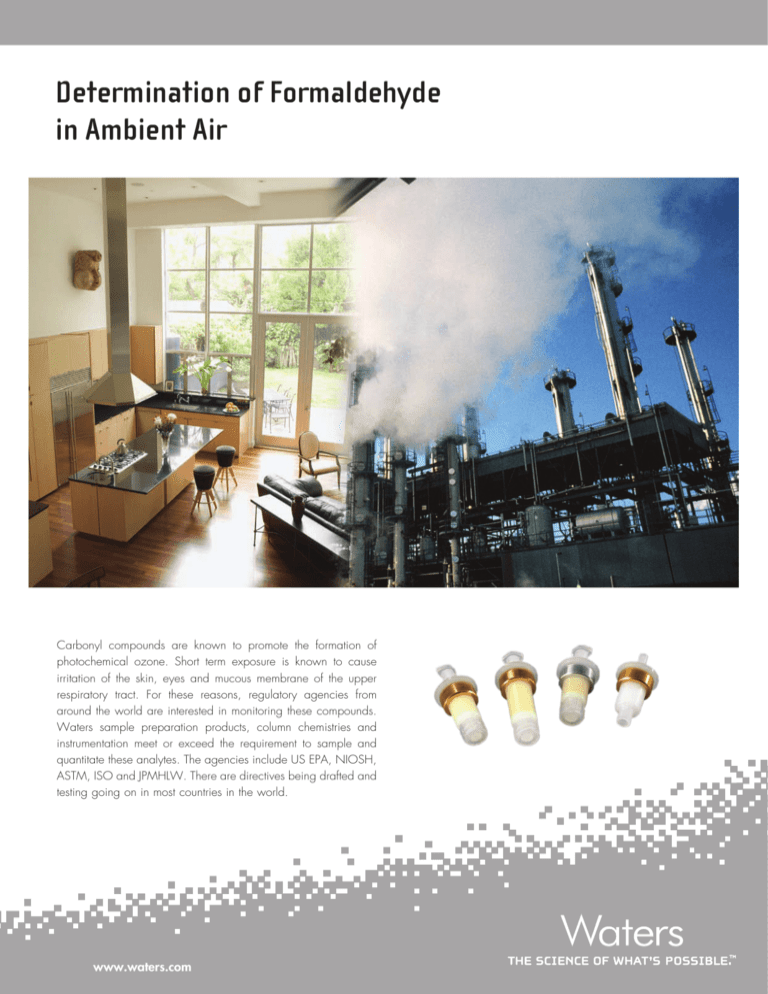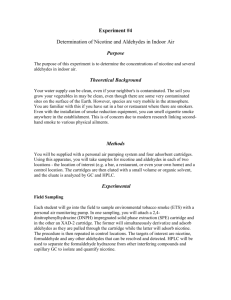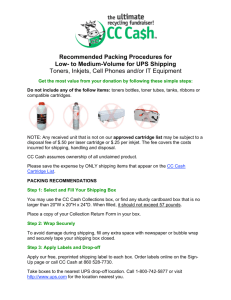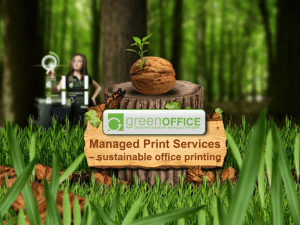Determination of Formaldehyde in Ambient Air
advertisement

Determination of Formaldehyde in Ambient Air Carbonyl compounds are known to promote the formation of photochemical ozone. Short term exposure is known to cause irritation of the skin, eyes and mucous membrane of the upper respiratory tract. For these reasons, regulatory agencies from around the world are interested in monitoring these compounds. Waters sample preparation products, column chemistries and instrumentation meet or exceed the requirement to sample and quantitate these analytes. The agencies include US EPA, NIOSH, ASTM, ISO and JPMHLW. There are directives being drafted and testing going on in most countries in the world. www.waters.com Sep-Pak DNPH-Silica Cartridges for Analyzing Formaldehyde and Other Carbonyl Compounds in Air ® Formaldehyde and other carbonyl compounds are receiving increasing attention both as toxic substances and as promoters in the photochemical formation of ozone in air. Source of aldehydes in residential buildings include plywood and particle board, insulation, combustion appliances, tobacco smoke and various consumer products. Aldehydes are released into the atmosphere in the exhaust of motor vehicles and other equipment in which hydrocarbon fuels are incompletely burned. •Sep-Pak DNPH-Silica cartridges meet the requirements of EPA Method TO-11A and ASTM-D-5791-1. ® •Results from impingers and these cartridges are in excellent agreement. •Solvent consumption, solvent exposure and hazardous waste disposal costs are reduced. •Sep-Pak DNPH-Silica cartridges provide superior convenience and reproducibility, making them ideal for field sampling and process monitoring applications. ® The most sensitive and specific method for analyzing aldehydes and ketones is based on their reaction with 2,4-dinitrophenylhydrazine (DNPH) and subsequent analysis of the hydrazone derivatives by HPLC. The hydrazones may be detected by absorbance in the ultraviolet region, with maximum sensitivity obtained between 350 and 380 nm. When carbonyl-containing compounds are adsorbed from air samples onto DNPH silica cartridges they are derivatized according to the following scheme: NO2 R1 R C= O (Aldehyde or Ketone) H 2NNH NO2 NO2 R1 H+ R C = NNH 2,4-Dinitrophenylhydrazine (DNPH) NO2 + H 2O DNPH Derivative Sep-Pak DNPH-Silica cartridges meet the requirements of EPA Method TO -11A, JPM HLW and ISO 16000 providing a convenient device for sample collection. Using a vacuum pump, an air sample is drawn through the new Sep-Pak DNPH-Silica cartridge. The aldehydes and ketones react with the DNPH and form the hydrazone derivatives, which are retained on the cartridge. Later, the hydrazones are eluted from the cartridge with acetonitrile and analyzed by HPLC or Waters ACQUITY UPLC Technology. Detection limits can be as low as 3 ppbv for a 100 liter sample. ® •Sep-Pak DNPH-Silica cartridges save time and increase productivity. ® •Low background for higher sensitivity. HPLC Separation of DNPH Derivatives of Common Aldehydes and Ketones Column: Sample: Mobile Phase: Gradient: Flow Rate: Injection: Detection: Nova-Pak® C18 3.9 x 150 mm Mixture of DNPH and DNPH derivatives in acetonitrile. A: Water/Acetonitrile/Tetrahydrofuran 60/30/10 v/v/v B: Water/Acetonitrile 40/60 v/v 3 mL 100% A for 1 minute, then linear gradient from 100% A to 100% B in 10 minutes 1.5 mL/min 20 µL 360 nm ® 1. DNPH 2. Formaldehyde-DNPH 3. Acetaldehyde-DNPH 4. Acetone-DNPH 5. Acrolein-DNPH 6. Propionaldehyde-DNPH 7. Crotonaldehyde-DNPH 8. Butanone-DNPH 9. Butyraldehyde-DNPH 10. Benzaldehyde-DNPH 11. Isovaleraldehyde-DNPH 12. Valeraldehyde-DNPH 13. o-Tolualdehyde-DNPH 14. m-Tolualdehyde-DNPH 15. p-Tolualdehyde-DNPH 16. Hexaldehyde-DNPH 17. 2,5-Dimethylbenzaldehyde-DNPH ® Advantages of Waters Sep-Pak DNPH-Silica Cartridges ® These cartridges provide you with significant advantages when compared to other techniques, such as liquid impingers, for the analysis of aldehydes and ketones. In addition, a new high speed, high resolution UPLC Technology application has been developed to provide excellent quantitation capability in the low parts-per-billion range. ® High-Level Example: HPLC Method: Aldehyde Profile from Diluted Auto Exhaust Emissions 0.060 1. 2. 3. 4. 5. 6. AU 0.045 0.030 Retention Analytes Time (min.) Formaldehyde 3.640 Acetaldehyde 4.572 Propionaldehyde 6.488 Isobutyladehyde 9.228 Isovaleraldehyde 12.469 n-Valeralhyde 13.220 Low-Level Example: Aldehyde Profile from Laboratory Air Lab Air Sample 1. DNPH 2. Formaldehyde-DNPH 4.8 ppbv 3. Acetaldehyde-DNPH 1.2 ppbv 4. Acetone-DNPH 118.0 ppbv 5. Butanone-DNPH 0.8 ppbv 6. Isovaleraldehyde-DNPH 0.7 ppbv Cartridge Blank (calculated for 100 liter sample) 1. DNPH 2. Formaldehyde-DNPH 0.35 ppbv 3. Acetaldehyde-DNPH 0.27 ppbv 4. Acetone-DNPH 0.34 ppbv Peak Widths (@50% of peak hight) 0.12 0.14 0.17 0.20 0.25 0.26 SN 386 256 159 109 70 65 HPLC 0.1 ppm 14 min. The sample was obtained in a chemical research laboratory using a portable sampling pump. One 0.015 1 2 hundred liters of air was drawn through the cartridge at 0.65 L/min. The sample was found to contain 3 4 5 0.000 0.00 14 min. 2.00 4.00 6.00 8.00 10.00 12.00 low concentration of formaldehyde (4.8 ppbv), acetaldehyde (1.2 ppbv) and methyl ethyl ketone (0.8 6 14.00 ppbv), but a significant amount of acetone (118 ppbv). Significant concentrations of acetone are 16.00 18.00 frequently found in laboratories because of its widespread use as a solvent. Ozone Scrubber Cartridge for Removing Ozone Interference When Monitoring Outdoor Air Ozone has been shown to interfere with the analysis of carbonyl compounds in air samples that have been drawn through cartridges containing silica-coated with 2,4-dinitrophenylhydrazine (DNPH). Waters Ozone Scrubber cartridges are designed to remove this ozone interference. These disposable devices are intended for use in series combination with the Sep-Pak DNPH-Silica cartridges or XPoSure Aldehyde Sampler cartridges. One Ozone Scrubber cartridge replaces the 1⁄4” diameter by 36” long copper ozone denuder located in the heated zone of sampling systems used for outdoor air monitoring (PAMS program). ® Air Sample In ™ Each Ozone Scrubber cartridge contains 1.4 grams of granular potassium iodide. When air containing ozone is drawn through this packed bed, iodide is oxidized to iodine, consuming the ozone, according to the following reaction: O3 + 2I— + H2O Flow Schematic for Air Sampling System Ozone Scrubber Cartridge DNPH-Silica or XPoSure™ Cartridge Vacuum Sampling Pump The theoretical capacity of a single cartridge is 4.2 mmoles of ozone (200 µg). The particle size of the potassium iodide granules is optimized for good mass transfer and flow characteristics. I2 + O2 + 2OH— XPoSure™ Aldehyde Sampler Cartridges for Monitoring Aldehydes in Indoor Air Based on an extension of our DNPH coating technology, XPoSure™ Aldehyde Sampler cartridges are the most sensitive active samplers available today. Low-Level Example: Aldehyde Profile from Laboratory Air 1 4 1. 2. 3. 4. 5. 6. Highest Sensitivity Compared to existing sampling tube technology which have high and variable backgrounds, XPoSure™ cartridges are guaranteed to give consistent low aldehyde backgrounds, cartridge-to-cartridge, lot-to-lot. DNPH Formaldehyde-DNPH Acetalhyde-DNPH Acetone-DNPH Butanone-DNPH Isovaleraldehyde-DNPH 2 High-Collection Efficiencies 3 5 6 You can achieve > 95% collection efficiencies for all aldehydes at flows of up to a liter per minute. And, you only need to use one cartridge - no breakthrough bed is necessary. Lab Air Sample Cartridge Blank 0 Low Pressure Drop - Use with Portable Personal Sampling Pumps Large particle size and higher porosity frits make this new XPoSure cartridge compatible with personal sampling pumps. ™ Easy-to-Use Sample, elute and shoot, it’s that easy. You’ll never have to break open and manipulate a glass tube again. And because the cartridges are made from high density polyethylene (HDPE), breakage is not a concern. 2 4 6 8 Time (minutes) 10 12 14 The above sample was collected in a chemical research laboratory using a portable sampling pump. One hundred liters of air was drawn through the cartridge at 0.65 L/min. The chromatogram shows ormaldehyde (4.8 ppbv), acetaldehyde (1.2 ppbv), acetone (118 ppbv), butanone (0.8 ppbv), and isovaleraldehyde (0.7 ppbv). www.waters.com Fast Analyses of Aldehydes and Ketones by ACQUITY UPLC® Technology Aldehydes and ketones can be analyzed as DNPH derivatives rapidly and efficiency using Waters ACQUITY UPLC Technology. Results can be obtained several times faster than conventional HPLC technologies. ® High-Level Example: UPLC Method: Aldehyde Profile from Diluted Auto Exhaust Emissions 0.088 1. 2. 3. 4. 5. 6. 0.066 AU 1 0.044 Analytes Formaldehyde Acetaldehyde Propionaldehyde Isobutyladehyde Isovaleraldehyde n-Valeralhyde Retention Time (min.) 0.429 0.502 0.652 0.863 1.114 1.175 Peak Widths (@50% of peak hight) 0.01 0.01 0.02 0.02 0.02 0.02 SN 791 553 351 236 143 132 2 3 0.022 4 5 6 0.000 0.00 0.20 0.40 0.60 0.80 1.00 1.20 1.40 1.60 1.80 Waters ACQUITY UPLC System ® ® Ozone Scrubber Sep-Pak DNPH-Silica Cartridge ® Description DNPH Short DNPH Long Part Number DNPH and XPoSure™ contains acidified dinitrophenylhydrazine reagent coated on a silica sorbent. Used for the collection of air samples and subsequent quantitation of aldehydes and ketones WAT037500 by reaction to form the hydrazone Box of 20 derivative, and analysis by HPLC. DNPH-Silica is specified in several EPA procedures for the analysis of carbonyl compounds in air. DNPH and XPoSure™ contains acidified dinitrophenylhydrazine reagent coated on a silica sorbent. Used for the collection of air samples and subsequent quantitation of aldehydes and ketones by reaction to form the hydrazone derivative, and analysis by HPLC. DNPH-Silica is specified in several EPA procedures for the analysis of carbonyl compounds in air. Mass/ Volume/Type Chemistry 1. Particle Size 55-105 µm 350 mg / 0.7 mL / Plus Short 2. Pore Size 125Å 3. Coating 14 µmoles/g or 5 µmoles/ cartridge XPoSure™ 1. Particle Size 55-105 µm WAT039550 Box of 20 Ozone Scrubber Potassium / Iodine 800 mg/ 1.6 mL/ Plus Long 2. Pore Size 125Å 3. Coating 14 µmoles/g or 10 µmoles/ cartridge Description Part Number Mass/Volume/Type For removing ozone interference with the analysis of carbonyl compounds. Use in series with Sep-Pak® DNPH or XPoSure™ cartridge. WAT054420 Box of 20 1.4 g / 1.6 mL / Plus Short Description Part Number Mass/Volume/Type Chemistry Larger particle dinitrophenylhydrazine coated silica for use with personal air monitors. WAT047205 Box of 20 350 mg / 0.7 mL / Plus Short 1. Particle size 500 - 1000 µm Chemistry 1. 1.4 g of potassium iodide 2. capacity 4.2 mmoles of ozone/cartridge HPLC/UPLC™ Columns Recommended for Separation of DNPH Derivatives Description Dimensions Particle Size Part Number Nova-Pak® C18 3.9 x 150 mm 4 µm WAT086344 Symmetry® C18 3.9 x 150 mm 5 µm WAT045905 ACQUITY UPLC® BEH Phenyl 2.1 x 100 mm 1.7 µm 186002885 ACQUITY UPLC® BEH Phenyl (3 pk) 2.1 x 100 mm 1.7 µm 186002885 www.waters.com Austria and European Export (Central South Eastern Europe, CIS and Middle East) 43 1 877 18 07, Australia 61 2 9933 1777, Belgium 32 2 726 1000, Brazil 55 11 5094 3788, Canada 1 800 252 4752 x2205, China 86 10 8586 8899, CIS/Russia 7 095 336 7000, Czech Republic 420 2 617 1 1384 Denmark 45 46 59 8080, Finland 09 5659 6288, France 33 1 30 48 72 00, Germany 49 6196 400600, Hong Kong 852 29 64 1800 Hungary 36 1 350 5086, India and India Subcontinent 91 80 2837 1900, Ireland 353 1 448 1500, Italy 39 02 27 421 1, Japan 81 3 3471 7191 Korea 82 2 820 2700, Mexico 52 55 5200 1860, The Netherlands 31 76 508 7200, Norway 47 6 384 60 50, Poland 48 22 833 4400 Puerto Rico 1 787 747 8445, Singapore 65 6273 1221, Spain 34 93 600 9300, Sweden 46 8 555 11 500, Switzerland 41 62 889 2030 Taiwan 886 2 2543 1898, United Kingdom 44 208 238 6100 All other countries: Waters Corporation U.S.A. 1 508 478 2000/1 800 252 4752 The quality management system of Waters’ manufacturing facilities in Taunton, Massachusetts and Wexford, Ireland complies with the International Standard ISO 9001:2000 Quality Management and Quality Assurance Standards. Waters’ quality management system is periodically audited by the registering body to ensure compliance. ©2007 Waters Corporation. Waters, ACQUITY, UPLC, ACQUITY UPLC, Nova-Pak, Sep-Pak, Symmetry, XPoSure and The Science of What’s Possible are trademarks of Waters Corporation. March 2007 720001988EN MC-CP






